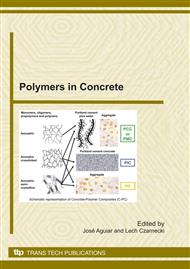[1]
V. V. Årskog, M. Ferreira and O.E. Gjørv: Durability and Performance of Norwegian Concrete Harbor Structures, Vol. 1, Proceedings. Fourth International Conference on Concrete Under Severe Conditions – Environment and Loading, edited by B.H. Oh, K. Sakai, O.E. Gjørv and N. Banthia, Seoul National University and Korea Concrete Institute, Seoul (2004).
DOI: 10.1201/b10552-93
Google Scholar
[2]
] M. Ferreira, V. Årskog, S. Jalali and O.E. Gjørv: Probability-Based Durability Analysis of Concrete Harbor Structures, Vol. 1, Proceedings. Fourth International Conference on Concrete Under Severe Conditions – Environment and Loading, edited by B.H. Oh, K. Sakai, O.E. Gjørv and N. Banthia, Seoul National University and Korea Concrete Institute, Seoul (2004).
DOI: 10.1201/b10552-93
Google Scholar
[3]
] O.E. Gjørv: Durability Design of Concrete Structures in Severe Environments, Taylor & Francis, London and New York (2009).
Google Scholar
[4]
IIInformation on http: /www. evonic. com.
Google Scholar
[5]
Information on http: /www. dowcorning. com.
Google Scholar
[6]
] NORDTEST: NT Build 492. Concrete, Mortar and Cement Based Repair Materials: Chloride Migration Coefficient from Non-Steady State Migration Experiments. Espoo (1999).
Google Scholar
[7]
Ő. Sengul and O.E. Gjørv: Electrical Resistivity Measurements for Quality Control During Concrete Construction, ACI Materials Journal Vol. 105 (2008), pp.541-547.
DOI: 10.14359/20195
Google Scholar
[8]
NORDTEST: NT Build 443. Concrete, Hardened: Accelerated Chloride Penetration, Espoo (1995).
Google Scholar
[9]
NTNU: Internal test method KB 71 127- Hydrophobic Surface Treatment. Measurements of Penetration Depth into Concrete, Trondheim (1998).
Google Scholar
[10]
Vogel: Textbook of Quantitative Inorganic Analysis, Fourth Edition (1978) pp.754-755.
Google Scholar
[11]
F. Tittarelli and G. Moriconi: The Effect of Silane-Based Hydrophobic Admixture on Corrosion of Reinforcing Steel in Concrete, Cement and Concrete Research, Vol. 38 (2008) pp.1354-1357.
DOI: 10.1016/j.cemconres.2008.06.009
Google Scholar
[12]
G. Liu: Control of Chloride Penetration into Concrete Structures at Early Age, PhD Thesis 2006: 46, Department of Structural Engineering, Norwegian University of Science and Engineering - NTNU, Trondheim (2006).
Google Scholar
[13]
B. Arntsen: In-Situ Experiences on Chloride Redistribution in Surface-Treated Concrete Structures, Vol. 1, Proceedings. Third International Conference on Concrete Under Severe Conditions – Environment and Loading, edited by N. Banthia, K. Sakai and O.E. Gjørv, The University of British Columbia, Vancouver (2001).
Google Scholar


